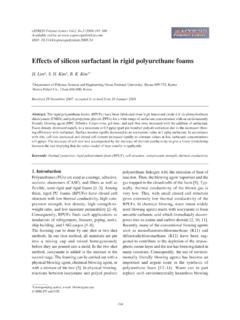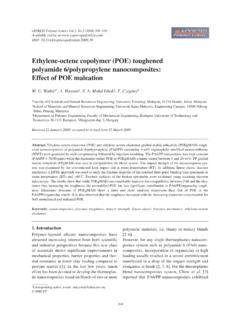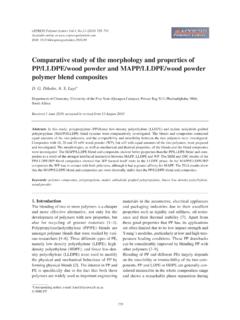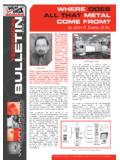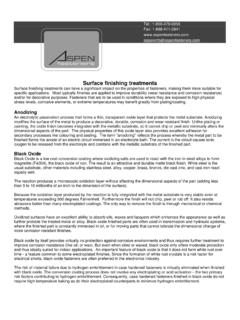Transcription of Fire-retardant and fire-barrier poly(vinyl acetate ...
1 1. IntroductionThere is considerable interest in the field of Fire-retardant polymer based materials as the demandfor improved safety in domestic, public and indus-trial situations is required by fire -safety most successful Fire-retardant compounds forpoly( vinyl acetate ) (PVAc) materials are those thatreact chemically with the substrate and act in thecondensed phase. Compounds that form part of acomposite ideally should exhibit multifunctionalability. Examples of such fire -retardants are mag-nesium hydroxide (Mg(OH)2) and zinc borate(2 ZnO 3B2O3 ).
2 fire retardants change thedecomposition path of polymers during heating soas to reduce the concentration of combustiblevolatiles and promote char formation. The charmay be intumescent, offering heat and fire resist-ance until it reaches a critical temperature abovewhich it burns [1 3].The use of intumescent char systems is importantfor building infrastructure protection where emul-sion polymers have been applied in coatings, paintsand sealants. On heat exposure of these type ofmaterials, activation and formation of an intumes-cent char occurs that provides an insulating barrierbetween the fire and the underlying substrate.
3 Anintumescent char normally results from a signifi-cant volume increase or thickness of a foam-likelayer. fire protection by coatings that proceed viaintumescence increase the path for heat transfer andincrease the thermal gradient from the charred sur-face to the substrate polymer [4]. A structurerequires stabilisation for a char with structuralintegrity to be formed, and this is achieved byfusion or by promoting adherence of condensedlayer components, such as formation of a ceramic-like phase. Various components are used to providethis function; a silicate mineral providing a struc-79*Corresponding author, e-mail: BME-PTFire- retardant and fire -barrier poly ( vinyl acetate )composites for sealant applicationZ.
4 Al-Hassany, A. Genovese, R. A. Shanks*CRC for Polymers, School of Applied Sciences, RMIT University, GPO Box 2476V Melbourne 3001, AustraliaReceived 4 May 2009; accepted in revised form 10 November 2009 Abstract. Fire-retardant ceramifying poly ( vinyl acetate ) (PVAc) sealants have been prepared. The degradation of PVA wasintegrated with the action of the fire retardants to reduce flammable gases, produce carbonaceous char and convert thefillers into a self-supporting ceramic barrier. PVA is readily degraded by elimination of acetic acid, yielding a char that pro-vides a transitory phase as the filler particles fuse into a ceramic mass.
5 Acetic acid is eliminated at similar temperature tothe release of water from magnesium hydroxide Fire-retardant , thereby diluting flammable acetic acid. The residual oxidefrom the Fire-retardant filler and structural filler are fused by a flux, zinc borate. The degradative and ceramifying processeswere characterised using thermogravimetry, infrared spectroscopy, scanning electron microscopy and ceramic of the composites was compared with additive mass loss curves calculated from the components. Devi-ations between the experimental and additive curves revealed interactions between the components in the composites.
6 Themodulus of the PVAc composites and the strength of their ceramic residues after combustion were :thermal degradation, poly ( vinyl acetate ), Fire-retardant , zinc borate, clayeXPRESS Polymer Letters , (2010) 79 93 Available online at : network, binders such as zinc borate that arecapable of forming an amorphous phase on soften-ing and a fluxing capability. Other components canbe added to provide fire retardant functions and toparticipate in structure formation [5 15].A series of kaolin and talc composites with varyingfiller content was investigated with particular atten-tion to the formation of a fused char or and kaolin were used to enhance the stiffnessand strength of the composite and ceramic materi-als.
7 In addition to the component properties, themechanical characteristics of these materials areinfluenced by the interfacial interactions thatdepend on the interface and the cohesive degradation of PVAc gives quantitativeyields of acetic acid, produced by an eliminationreaction leading to a polyalkene residue [16, 17].This process gives rise to the formation of an intu-mescent residue with conjugated C=C bonds withcyclic and aromatic structures [18]. The doublebonds produced by the elimination of acetic acidlead to an increase in the rate of adjacent thermaldegradation.
8 The degradation of PVAc occurs intwo stages: the first stage starts at 350 C, and thesecond stage at 400 C. Simultaneously, the fireretardants undergo decomposition over similartemperature ranges although their presenceenhances the PVAc thermal stability. The PVAcintumescent char maintained the structure while aceramic-like residue formed. The importance inmaintaining a structure throughout the polymerdecomposition and ceramic formation was influ-enced by the filler system and amount that is shownby the scanning electron microscopy (SEM) aim was to interpret the action of ceramic bar-rier forming components on PVAc composites andtheir interactions according to their thermal decom-position reactions and analytical temperature structural analyses.
9 The changes in char structure ofthe pure polymer and the composite with tempera-ture were identified with Fourier transform infrared(FTIR) spectroscopy. An objective was the forma-tion of a fused ceramic char that provides cohesivestrength to maintain structural integrity during andafter a fire . The effect of mineral type (kaolin ortalc) and filler amount on the structure formed wasevaluated through thermal stability measurementsby thermogravimetry (TGA) and strength of charformed at elevated temperature. fire retardantsealant composites mechanism of action as fire -retardants in conjunction with char forming compo-nents that form a structural ceramic to maintain sealintegrity is MaterialsPVAc was obtained from Nuplex Industries Pty Ltd(Australia) as an emulsion of 55% homopolymer inwater.
10 The calcined kaolin (K) was obtained fromBurgess Pigment Company, Sandersville, GA,USA. The talc (T)(T38A) was obtained fromUnimin Ltd, Australia. Magnesium hydroxide(M)(Magnifin 10H) was obtained from Magnesi-aprodukte GmbH and Company KG, borate (ZB)(Firebrake ZB) was obtained fromUS Composite preparationThree sets of composites were prepared with vary-ing polymer weight fraction ( , , and ).The filler mixtures have composition: Set A con-taining kaolin ( ), Mg(OH)2( ), zinc borate( ) and glass frit ( ), Set B containing mineral(either kaolin or talc) ( ), Mg(OH)2( ), glassfrit ( ) (without zinc borate), and Set C contain-ing talc ( ), Mg(OH)2( ), zinc borate ( )and glass frit ( ).
